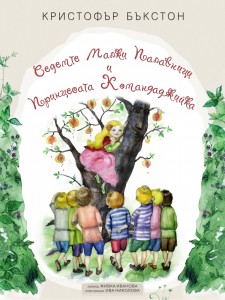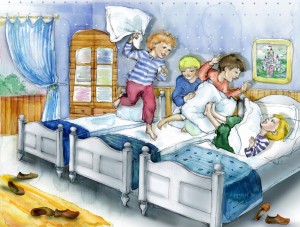The most significant trend in Bulgarian writing over the last three years has been a re-evaluation of recent history, however painful. Novels like The Heights by Milen Ruskov, The Paleevi sisters by Alec Popov and now One and the Same Night by Christo Karastoyanov are effectively challenging the mythology created by 45 years of Communist rule. In these novels “revolutionary heroes” and “fascist/Turkish villains” emerge as complex human beings with their fluctuating motivations, driven by personal and public contexts.
One and the Same Night is an account of the last three years in the lives of two young friends, murdered by Government agents on the same night in 1925. The more famous of the two was Geo Milev, poet, war hero, editor and translator. His body and his glass eye were found and identified much later in a mass grave. An autopsy showed that his already damaged skull had been smashed but that he’d also been strangled with wire. Somewhere else at the same time his friend and patron, the anarchist Georgi Sheytanov was shot and decapitated. Both men were victims of a government white terror campaign, following the Communist bomb outrage at the Saint Nedelya Cathedral. In Communist Bulgaria Geo Milev was accorded the status of an anti-fascist hero, although in his life he had vigorously opposed linkage of his name to any political cause or party. Geo Milev was a serious promoter of avant-garde expressionist poetry. Having lost an eye and part of his skull in WW1 he campaigned for the rights of neglected veterans. His poem September written following an unsuccessful uprising against the then military dictatorship that had overthrown a democratically elected government. This was the poem that got the celebrated poet into trouble. He was given a surprisingly short prison term for “encouraging class hatred”, but before he could serve his term he was abducted – probably on the orders of General Vulkov. The Communists subsequently turned him into a hero, wrongly claiming him as their own. The school I taught at was named after him.
Sheytanov was forgotten.
Sheytanov was an anti-Communist anarchist, with a huge price on his head. Although never directly involved in any terrorist outrage, he had a romantic inclination towards bombs and assassinations of monarchs and government leaders. More than Geo Milev, Sheytanov felt sure that he was operating in a civil war situation, where so called allies could be your greatest enemies. He financed the publication of Milev’s periodical.
Christo Karastoyanov writes their story in non-consecutive short sharp episodes – each episode is titled with the date on which it was written. This technique brilliantly distances readers from the dramatic events as they unfold, while keeping them close to the writer and his creative impulses. The juxtaposition of remote events with immediate present allows for parallels to be drawn – for example the story of Victor Jara. What remains is the universal story of fear leading to repression and brutality and the writers’ unwitting instinct to speak out.
The laconic distancing strategy stops the story from becoming maudlin and melodramatic. There are even comic moments as when Sheytanov tries to stowaway on a Russian cruise liner. Throughout this spare but vivid the reader is encouraged to confront issues that have never gone away – to what extent violent action taken either by the state or by terrorists can ever be justified.
‘Uncategorized’ Category
-
“One and the Same Night” by Christo Karastoyanov
July 19, 2014 by Christopher Buxton
-
Dancing in the lift – my first night in Oslo 1975
July 19, 2014 by Christopher Buxton
The hottest summer in years – and I spend it in specialist shops buying padded anoraks, sweaters, thermal underwear and mountain boots. I’ve signed a contract with the Norwegian ministry of Education to work in a village school for at least a year– and I can’t find the place on any map. Never mind, I pack my St Edmund’s school trunk and heavy duty grip and make my way to Newcastle Docks to meet up with 6 fellow contractees, similarly luggaged up. We’re all bound for different parts of Norway but we have a week’s survival induction in Oslo via ferry to Bergen and spectacular train journey. So two days later, we haul our bags and trunks off the train at Oslo railway station, load up various taxis and arrive at our designated hotel.
The hotel occupies the third, fourth and fifth floors of a modern block. With much sweat and muscle strain we fill the lift with our luggage – there’s space for two of us and the rest take the stairs. The lift is doorless, so we watch the wall slide past as we keep the luggage pile from toppling over. At the third floor, I stay by the lift while my colleagues sort out our rooms. No problem so in a few minutes my colleague and I are back in the lift. He presses the fifth floor button, but the lift obeys a previous summons and descends to the ground floor where baffled folk have been waiting for the last ten minutes. They open the door to see the compartment filled with two sweating men holding on to tottering piles of luggage. They close the door and the lift lurches upwards. We reach the fifth floor to find that the outer door cannot be opened. We later understand the hotel has a problem with absconding guests. We press 3 to return to reception. Inevitably our journey takes past the ground floor where the same folk are becoming understandably restless. Back on the reception floor, my colleague gives way to the concierge who carries an impressive bunch of keys. We make our way to the fifth floor, again via the ground floor. At least the concierge’s considerable bulk offers some protection from the hot volley of complaints. The lift is now making alarming groaning noises as we ris to the fifth floor. The concierge finds the right key and inserts it, but before he is able to turn it, the lift shudders and begins to descend again, leaving his ring of keys to dangle precariously over the lift shaft. The concierge now performs dance of fury – quite impressive given his size and the lack of space. And I get my first lesson in Norwegian swearing.
-
Oops what’s the Bulgarian for “Bossy”?
March 13, 2014 by Christopher Buxton
Oops
 Or a case of Bulgarian being more PC than English
Or a case of Bulgarian being more PC than EnglishI now understand that the title of my new children’s story will be rightly attacked by a group of feminists, led by no less a person than Beyoncé. They have called for the word “Bossy” to be banned from all electronic media, arguing that it is part of a male dominated language system designed to undermine the confident self-image of assertive girls and young women.
Seeing the justice of this view, I bow my head in shame. As Hadley Freeman pointed out in the Guardian what are seen as leadership skills in boys can be dismissed in a single adjective where girls are concerned. Hadley does add though that as a child her greatest role model was Miss Piggy.
“The Bossy Princess and the Seven Scallywags” is based on the stories I used to tell our ten year old daughter and four year old son in a desperate attempt to stop them fighting as they sat in the back seat of our car on the long
 journey between England to Bulgaria. I guess the conflicts between order loving sister and disruptive younger brother led to my fairy tale celebration.
journey between England to Bulgaria. I guess the conflicts between order loving sister and disruptive younger brother led to my fairy tale celebration.In conversations with my Bulgarian translator we realised that there was no Bulgarian word for bossy. Clearly Bulgarians have anticipated Beyoncé by thousands of years. Perhaps the historic assertiveness of most Bulgarian women has rendered the concept of “bossiness” irrelevant if not tautological.
Well at least if Beyoncé can only read Bulgarian I should be in the clear but should she read the Publisher’s blurb, I can expect trouble.
Meet Smartina, the bossiest of bossy princesses. While her Daddy the King is away fighting dragons, she’s the queen of the castle and her word is law. All too soon though, she is threatened by a rival. Before she can issue a new command she is drugged, put in a sack and left outside a bears’ cave in the middle of an impenetrable forest. Lucky for her that she is rescued by a magic house and garden. But this is where the seven rumbustious little scallywags live – and she will face the greatest challenge to her bossiness. An enchanting tale for 7-11 year olds.
-
Extract from new children’s book with illustration by Iva Nikolova
February 24, 2014 by Christopher Buxton
D own, down, in the deepest valley in Yagador, the darkest forest to be found in the King’s realm, lived the seven little scallywags. They lived in a magic house and garden surrounded on all sides by an impassable hedge of brambles.
No-one knew how they had come to live in a magic house and garden – because no-one knew they were there. No paths led through the deep forest centre. And you’d need long stilts to peep over the bramble hedge into the garden where the sun shone every day and at night the stars twinkled.
The little scallywags couldn’t tell you either. They had lived in the magic house for as long as they could remember and life was such fun!
Every morning they
 woke up as the first rays of the sun spilt through the windows of their bedroom. They would jump out of bed and after a jolly pillow fight they would rush downstairs for breakfast.
woke up as the first rays of the sun spilt through the windows of their bedroom. They would jump out of bed and after a jolly pillow fight they would rush downstairs for breakfast.They never needed to dress because they slept in their clothes.
You might think these little scallywags must have been very stinky if they never changed their clothes. But these were magic clothes that cleaned themselves every fifteen minutes.
So they rushed downstairs, pushing and shoving and sure enough, there on the magic table were seven bowls of thick creamy kangleberry yoghurt and piles of buttery toast.
“Eat, seat, what a treat!” sang the little scallywags, as they swallowed delicious dollops and gobbets and played flick in the eye with spoons loaded with yoghurt.
“Time to play: clear away!” they shouted as they ran from the table into the tunnel that led to the sunny garden. Behind them the magic table swallowed the dirty dishes and invisible hands swept the floor and mopped up any mess. In the tunnel, sprays of warm water, giant soapy flannels and hot air washed them down and dried them in a split second.
Out in the garden, each day began with a song and a dance. The seven little scallywags joined hands in a ring and began to hop and skip, always to their left, faster and faster till they were like a whirring whirligig. And they sang this song:
Stinky slinky onions
My shoes are full of bunions
A bumpa! A flumpa!
We all fall down.
And at the word down each scallywag let go of his partners’ hands and the force of the whirling ring flung his body outwards, so he rolled and rolled to the very edge of the lawn.
The little scallywags were like India rubber balls. They never got a cut or bruise. They just bounced up and bounded towards each other in a game of Pushme-shoveyou. This boisterous game had them bumping, sprawling and rolling and jumping up and bumping again.
In the house the oven hummed, saucepans hissed. The magic house was cooking a delicious lunch for the seven little scallywags. When they came back from the garden, huffed and puffed, sluiced and spruced, there were seven heaped plates of gozzlywiggle stew with as many roast kissnips as seven scallywags could eat. This lip smacking feast was helped down with jugs of toffee beer.
After lunch there were more games of Hunt the jumper, Blind bopper, Shufflebottom and Bulldog Scallywag 1-2-3.
Often around three o’clock when the sun was at its warmest, the little scallywags felt sleepy and rolled themselves up on the lawn for a spell of ninety winks. An hour later, they were stretching and yawning. In a trice they were jumping up and down under the fruit salad tree, hands behind their backs playing a game of Snap’nchomp. Sticky juice ran down their chins, their necks and under their vests.
You would think that by tea time, when it got dark, the seven scallywags would have knees as muddy as potatoes and faces as sticky as fly paper. But the tunnel did its work. They were washed and wiped as clean as cars in a carwash, then dried as dry as autumn leaves in the wind.
“Mmmm! Mmmm! Mmmmm!” The little scallywags murmured for there on the table were piles of pancakes dripping in pinknut syrup and steaming mugs of chocolate soup.
And later as they ran upstairs, tired and yawning, invisible flannels and toothbrushes scrubbed and brushed and driers blew away the damp, and each scallywag curled up in their beds. Clean sheets and blankets covered them to their very noses and the house sang a lilting lullaby.
Goodnight sweet scallywags! Another day tomorrow!
And the scallywags fell asleep.
-
The Bossy Princess and the Seven Scallywags
February 24, 2014 by Christopher Buxton
Meet Smartina, the bossiest of bossy princesses. While her Daddy the King is away fighting dragons, she’s the queen of the castle and her word is law. All too soon though, she is threatened by a rival. Before she can issue a new command she is drugged, put in a sack and left outside a bears’ cave in the middle of an impenetrable forest. Lucky for her that she is rescued by a magic house and garden. But this is where the seven rumbustious little scallywags live – and she will face the greatest challenge to her bossiness. An enchanting tale for 7-11 year olds.
This was a story I invented to entertain our two children, strapped into the backseat of our car, separated by a Berlin wall of luggage, on our annual migration from England to Bulgaria. In the interest of gender politics and family peace I have to declare that no assumptions should be made about the resemblance of characters in the book to real persons. I am as ever indebted to my wonderful wife for her encouragement.
For further details please visit my publishers’ site:


